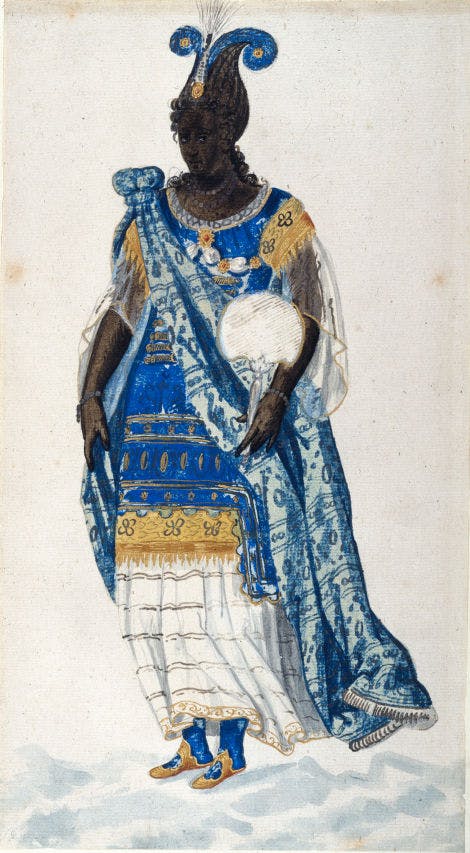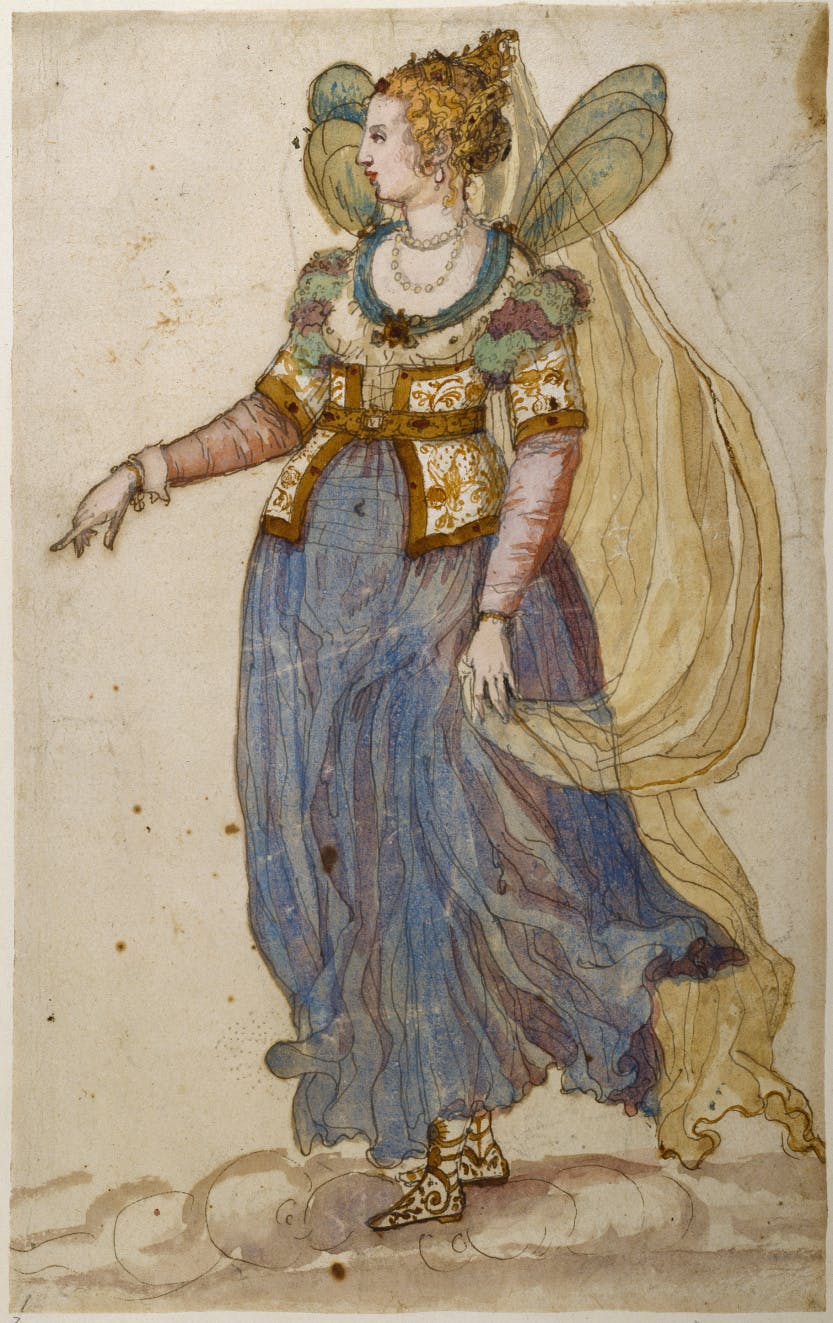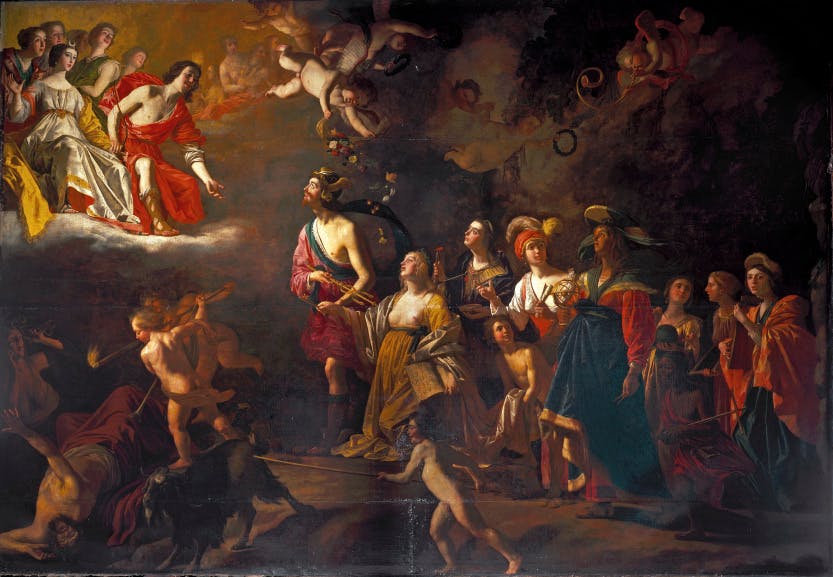 | |||||||||||||||||||||||||||||||||||||||||||||||||||||||||||||||||||||||||||||||||||||||||||||||||||||||||||||||||||||
| Costume design by Inigo Jones for Queen Anne's "Masque of Blackness" |
 |
| Another design by Inigo Jones for one of Henrietta Maria's masques |
 |
| The court of Charles I in costume in a classical fantasy, Buckingham and his life Katherine are staring up at Charles I and Henrietta Maria. |
 |
| Henrietta Maria of France |
Masques were a big part of court life in both the English and French courts of the seventeenth century, especially during Shrovetide. From Historic Royal Palaces:
The masque began as an improvised performance at court in the 16th century during which courtiers and even royals would disguise themselves for play acting, fun and dancing.Masques were staged at Whitehall and Hampton Court Palaces for the Stuarts, with singing, acting, music, dialogue, amazing costume and above all, ‘special effects’ and moving scenery. By the early 1600s, under masque-loving monarchs James I and his queen Anne of Denmark, it became really elaborate.
A Banqueting House was built specifically for the performance of masques at Whitehall Palace in 1608, but this burnt down in 1619, and was replaced by the present building, designed by Inigo Jones and completed in 1622.The Stuart Masques were mostly created by the brilliant partnership of playwright Ben Jonson and set and costume designer Inigo Jones. These temperamental artists quarrelled over whose contribution was more important, and after 1632, Jones worked with less argumentative (and less talented) poets.
The masques were a heady combination of opera, theatre, ballet and ball. They were always allegorical, featuring gods and goddesses from mythology and British history. Their purpose was to demonstrate the wisdom, and God-given right to rule, of the Stuart monarchs. There was always an ‘anti-masque’, featuring wild and outlandish dancers, who symbolised the chaos of a kingdom before the Stuarts. This was followed by the masque proper portraying the idealistic world of peace and harmony under divine kingship. At the end of the masque, the King would dance, and then the courtiers. Masques were performed for, rather than by, the court, although sometimes the queen and her ladies danced.
A masque was also a place to see and be seen. They were incredibly expensive to produce; some of the most lavish were staged by affluent lawyers. But despite the cost, they weren’t always the most comfortable of shows to attend, for either actors or audiences. The crowded room was stifling hot, and smoke from the hundreds of torches must have been oppressive. Sometimes there was a long delay before the performance began. The chaplain to the Venetian Ambassador wrote of his experience after attending a masque in 1618: ‘So crowded and uncomfortable that had it not been for our curiosity we would have given up or expired … every box was filled notably with the most noble and richly arrayed ladies… During the two hours of waiting we had leisure to examine them again and again.’ (Read more.)
From Luminarium:
HAD Ben Jonson never lived, the English masque would scarcely need to be chronicled among dramatic forms. For despite the fact that mumming, disguising, and dancing in character and costume were pastimes in England quite as old, if not older, than the drama itself, it is to Jonson that we owe the infusion of dramatic spirit into these productions, together with the crystallization of their discordant elements into artistic unity and form. Generically, the masque is one of a numerous progeny, of more or less certain dramatic affiliation. Specifically, a masque is a setting, a lyric, scenic, and dramatic framework, so to speak, for a ball.1 It is made up of "a combination, in variable proportions, of speech, dance, and song;" and its "essential and invariable feature is the presence of a group of dancers . . . called masquers."2 These dancers — who range in number from eight to sixteen — are commonly noble and titled people of the court. They neither speak nor sing, nor is it usual to exact of them any difficult or unusual figures, poses, or dances. Their function is the creation of "an imposing show" by their gorgeous costumes and fine presence, enhanced by artistic grouping, and by the aids which decoration and scenic contrivance can lend to the united effect. On the other hand, the speech of the masque, whether of presentation or in dialogue, and the music, both vocal and instrumental, were from the first in the hands of the professional entertainer, and developed as other entertainments at court developed. The masque combined premeditated with unpremeditated parts. The first appearance of the masquers with their march from their "sieges" or seats of state in the scene, and their first dance — all designated the "entry" — was carefully arranged and rehearsed; so also was the return to the "sieges" or "going cut," and this preparation included sometimes the preceding dance. The "main," too, or principal dance, was commonly premeditated, as in Jonson Masque of Queens, where the masquers and their torchbearers formed in their gyrations the letters of the name of Prince Charles. Between the "main" and the "going out," two extemporal parts were interpolated, the "dance with the ladies" and the "revels," which last consisted of galliards, corantos, and la voltas. It was in the development of the "entry" and the "main" that the growth of the masque chiefly consisted. (Read more.)
From Dr. Lawrence Shafe:
There was an Italian tradition, particularly a Florentine tradition, called the intermezzi. These were entertainments designed to fill in the gap between plays. The key series was in 1589 when the Grand Duke got married. They were trying to recreate a Roman theatre with classical allegory in the form of an entertainment. Bernado Buontalenti was the architect engineer of these displays.
A 1600 Florentine drawing shows a mountain rising from a stage, at the top is Pegasus with Apollo and the Muses below and Poetry below them. Clouds float in with people in them and they have trees that sprout leaves. Light boxes were used containing multiple candles made brighter with mirrors and the theatres were not darkened as much as ours. This event was publicized across Europe and news came back to Henry, Prince of Wales. His friend John Harrington was in Florence and wrote back describing them.
The intermezzi increased the scale and the engineering (trap doors, revolving stages) and it was these the Stuart court wanted to emulate.
Ben Johnson and Inigo Jones were the great double act although they eventually fell out.
Caroline masques in England had a stage with a proscenium arch (first developed in the 16thC in Florence and picked up by Jones). The stage tilts at an angle and it has slots in the sides for scenery. In 1635 Inigo Jones a country scene for The Temple of Love. 1609 Jones, [at] The Masque of Queens for Anne of Denmark [made] a machine with a round arch doorway and a revolving section on top with seats. The machine was called machina versitilis.
Anne of Denmark was the prime mover to create these spectacular masques. She loved dancing and was the leading dancer. She singled out Ben Johnson but the ideas were unfortunately hers so they were all a bit thin. All the music and choreography has been lost, in fact the scenery was pulled down and destroyed as soon as the masque was over. They were modelled on the French ballet do corps where the dancers formed a complex pattern. James I never ever took part. (Read more.)
HERE is the original program for the ballet danced by Henrietta Maria at the Louvre when Charles first saw her.
An article on the masques of Queen Henrietta Maria, HERE.
More on the stage props created by Inigo Jones, HERE.
My novel on Henrietta Maria, HERE.Share

















No comments:
Post a Comment